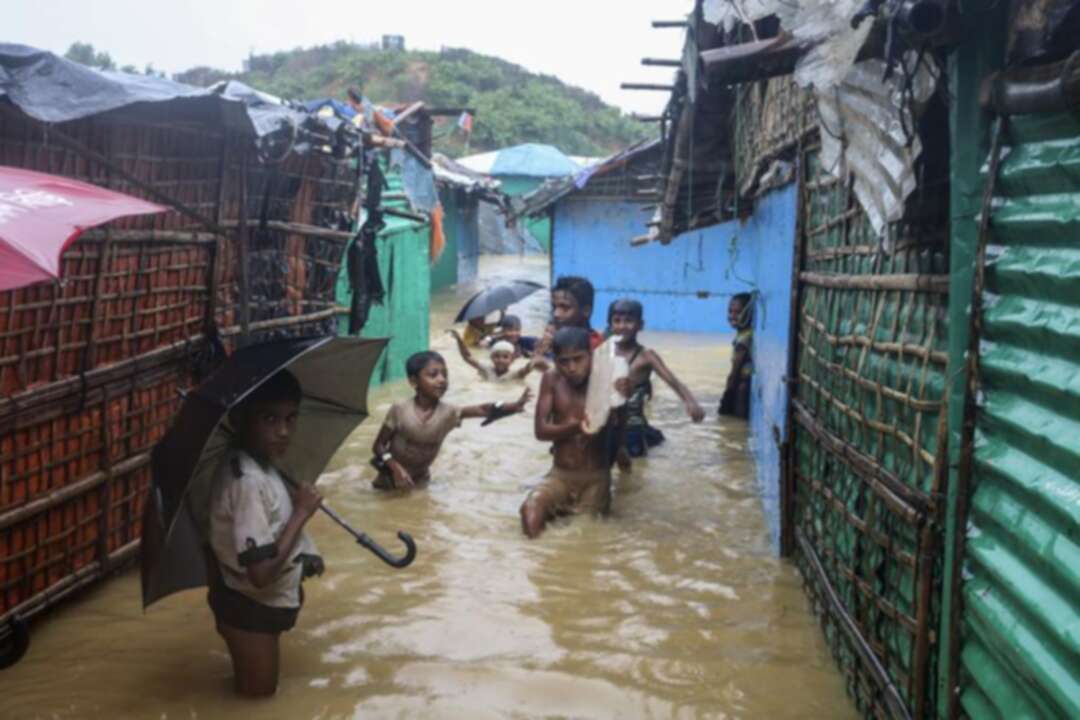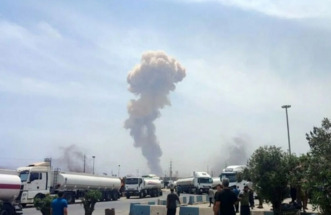-
Floods make thousands homeless in Bangladesh Rohingya camps

According to the AP, Days of heavy rainfall have pelted Rohingya refugee camps in southern Bangladesh, destroying dwellings and sending thousands of people to live with extended family or in communal shelters.
Just in the 24 hours to Wednesday alone, more than 30 centimeters (11.8 inches) of rain fell on the camps in Cox’s Bazar district hosting more than 800,000 Rohingya, the U.N. refugee agency said. That’s nearly half the average July rainfall in one day while more heavy downpours are expected in the next few days and the monsoon season stretches over the next three months.
“The situation is further compounded by the COVID-19 pandemic. There is currently a strict national lockdown in response to rising cases across the country,” the agency said.
The agency said it was saddened by the deaths of six people at the camps earlier this week, five in a landslide caused by the rains and a child swept away by floodwaters.
Rohingya refugee children play in flood waters at the Rohingya refugee camp in Kutupalong, Bangladesh, Wednesday, July 28, 2021. Days of heavy rains have brought thousands of shelters in various Rohingya refugee camps in Southern Bangladesh under water, rendering thousands of refugees homeless. (AP Photo/ Shafiqur Rahman)
1 of 10
Rohingya refugee children play in flood waters at the Rohingya refugee camp in Kutupalong, Bangladesh, Wednesday, July 28, 2021. Days of heavy rains have brought thousands of shelters in various Rohingya refugee camps in Southern Bangladesh under water, rendering thousands of refugees homeless. (AP Photo/ Shafiqur Rahman)
DHAKA,Bangladesh (AP) — Days of heavy rainfall have pelted Rohingya refugee camps in southern Bangladesh, destroying dwellings and sending thousands of people to live with extended family or in communal shelters.
Just in the 24 hours to Wednesday alone, more than 30 centimeters (11.8 inches) of rain fell on the camps in Cox’s Bazar district hosting more than 800,000 Rohingya, the U.N. refugee agency said. That’s nearly half the average July rainfall in one day while more heavy downpours are expected in the next few days and the monsoon season stretches over the next three months.
“The situation is further compounded by the COVID-19 pandemic. There is currently a strict national lockdown in response to rising cases across the country,” the agency said.
The agency said it was saddened by the deaths of six people at the camps earlier this week, five in a landslide caused by the rains and a child swept away by floodwaters.
ADVERTISEMENT
Citing initial reports, the U.N. High Commissioner for Refugees said more than 12,000 refugees were affected by the heavy rainfall while an estimated 2,500 shelters have been damaged or destroyed. More than 5,000 refugees have temporarily been relocated to other family member’s shelters or communal facilities, the agency said in a statement.
Refugees said they were struggling to eat or drink properly.
“Due to the continuous rainfall for the last four days, today my house is full of water,” says Khatija Begum, who has five children. “We are not even able to eat.” Begum says she fears her children will drown and die in their sleep.
Cyclones, heavy monsoon rains, floods, landslides and other natural hazards are an annual difficulty in the camps. More than 700,000 Rohingya have lived in refugee camps in Bangladesh since August 2017, when the military in Buddhist-majority Myanmar began a harsh crackdown on the Muslim ethnic group following an attack by insurgents.
The crackdown included rapes, killings and the torching of thousands of homes, and was termed ethnic cleansing by global rights groups and the United Nations. While Bangladesh and Myanmar have sought to arrange repatriations, the Rohingya are too fearful to return home.
The International Organization for Migration says Cox’s Bazar district, where more than 1 million Rohingya refugees live, is one of the most disaster-prone parts of Bangladesh.
It is a delta nation crisscrossed by many rivers that gets intense rainfall regularly due to its monsoon climate and location on the Bay of Bengal, where the warm waters can generate destructive tropical cyclones.
You May Also Like
Popular Posts
Caricature
BENEFIT Sponsors BuildHer...
- April 23, 2025
BENEFIT, the Kingdom’s innovator and leading company in Fintech and electronic financial transactions service, has sponsored the BuildHer CityHack 2025 Hackathon, a two-day event spearheaded by the College of Engineering and Technology at the Royal University for Women (RUW).
Aimed at secondary school students, the event brought together a distinguished group of academic professionals and technology experts to mentor and inspire young participants.
More than 100 high school students from across the Kingdom of Bahrain took part in the hackathon, which featured an intensive programme of training workshops and hands-on sessions. These activities were tailored to enhance participants’ critical thinking, collaborative problem-solving, and team-building capabilities, while also encouraging the development of practical and sustainable solutions to contemporary challenges using modern technological tools.
BENEFIT’s Chief Executive Mr. Abdulwahed AlJanahi, commented: “Our support for this educational hackathon reflects our long-term strategic vision to nurture the talents of emerging national youth and empower the next generation of accomplished female leaders in technology. By fostering creativity and innovation, we aim to contribute meaningfully to Bahrain’s comprehensive development goals and align with the aspirations outlined in the Kingdom’s Vision 2030—an ambition in which BENEFIT plays a central role.”
Professor Riyadh Yousif Hamzah, President of the Royal University for Women, commented: “This initiative reflects our commitment to advancing women in STEM fields. We're cultivating a generation of creative, solution-driven female leaders who will drive national development. Our partnership with BENEFIT exemplifies the powerful synergy between academia and private sector in supporting educational innovation.”
Hanan Abdulla Hasan, Senior Manager, PR & Communication at BENEFIT, said: “We are honoured to collaborate with RUW in supporting this remarkable technology-focused event. It highlights our commitment to social responsibility, and our ongoing efforts to enhance the digital and innovation capabilities of young Bahraini women and foster their ability to harness technological tools in the service of a smarter, more sustainable future.”
For his part, Dr. Humam ElAgha, Acting Dean of the College of Engineering and Technology at the University, said: “BuildHer CityHack 2025 embodies our hands-on approach to education. By tackling real-world problems through creative thinking and sustainable solutions, we're preparing women to thrive in the knowledge economy – a cornerstone of the University's vision.”
opinion
Report
ads
Newsletter
Subscribe to our mailing list to get the new updates!






















